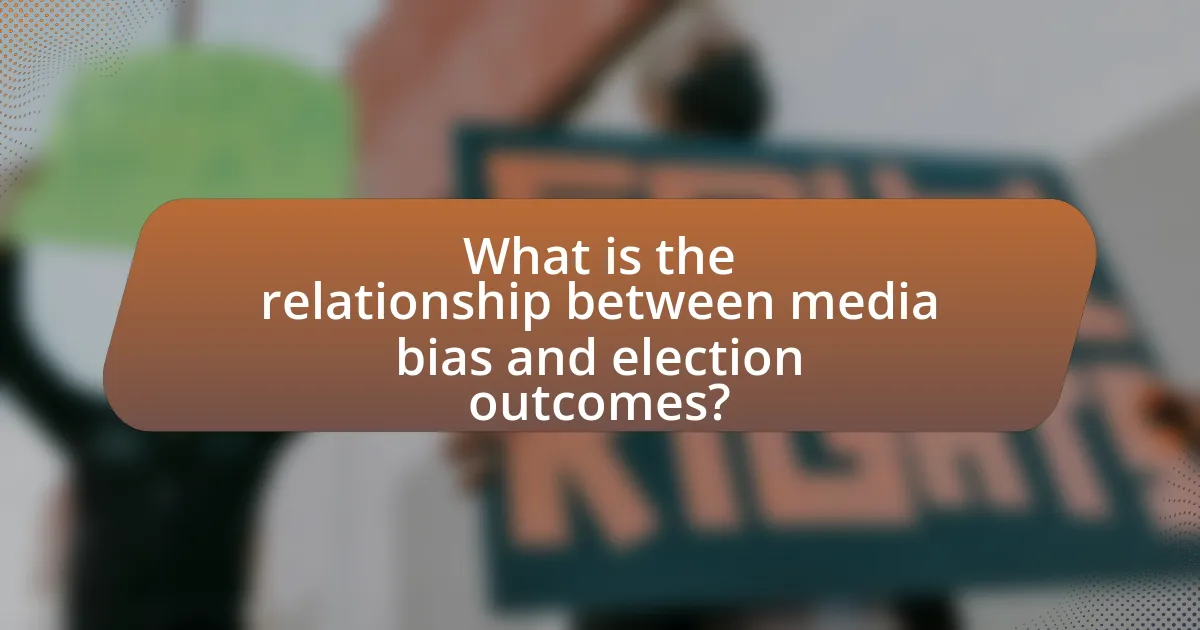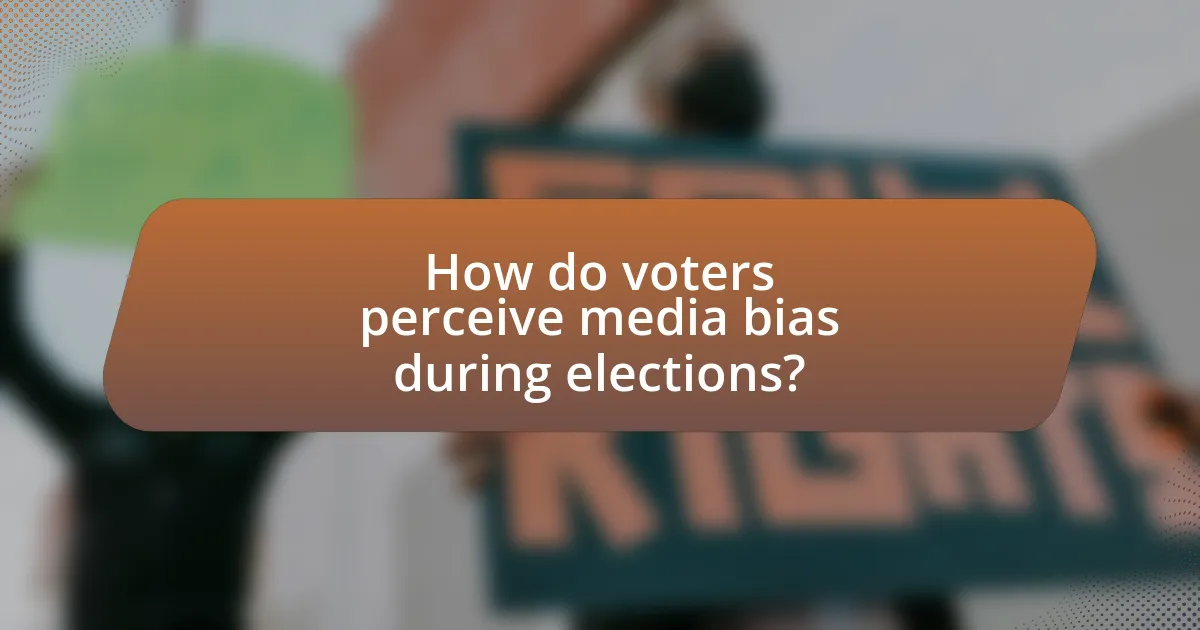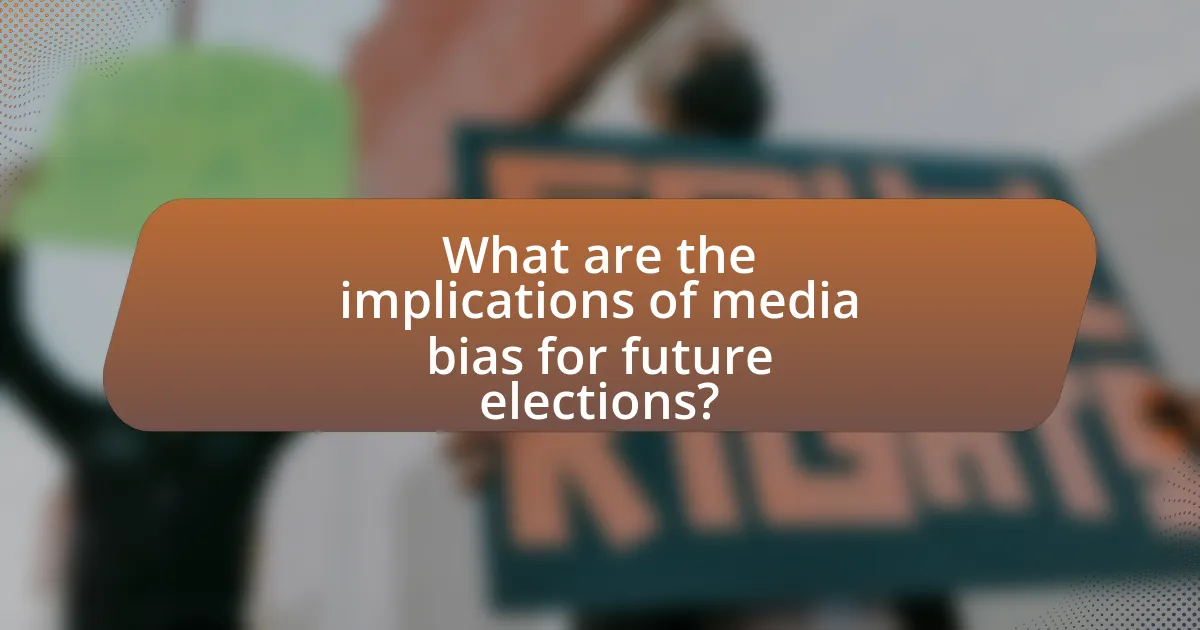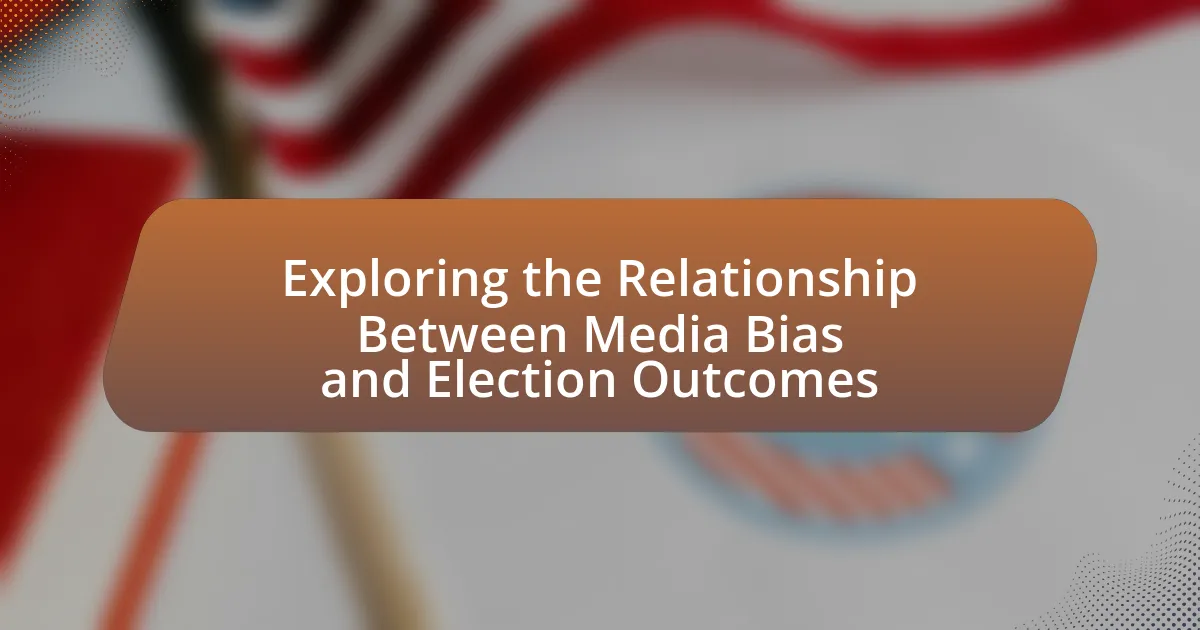The article examines the significant relationship between media bias and election outcomes, highlighting how biased reporting shapes public perception and influences voter behavior. It discusses various manifestations of media bias, including selection, framing, and confirmation bias, and their effects on candidates’ public images. The article also explores how voters perceive media bias, the implications for future elections, and strategies for voters to navigate biased information. Additionally, it emphasizes the importance of media literacy and critical evaluation of news sources to foster informed decision-making during elections.

What is the relationship between media bias and election outcomes?
Media bias significantly influences election outcomes by shaping public perception and voter behavior. Biased reporting can lead to skewed representations of candidates and issues, ultimately affecting voter decisions. For instance, a study by the Pew Research Center found that 62% of Americans believe that news organizations favor one side in their coverage, which can sway undecided voters and reinforce existing biases among partisan audiences. Additionally, research published in the Journal of Politics indicates that exposure to biased media can alter voters’ preferences, demonstrating a direct correlation between media bias and electoral results.
How does media bias manifest in political reporting?
Media bias in political reporting manifests through selective coverage, framing, and language that favor one political perspective over another. For instance, studies have shown that news outlets may prioritize stories that align with their ideological leanings, leading to an imbalance in the representation of political events. A notable example is the coverage of the 2016 U.S. presidential election, where different networks exhibited varying degrees of positivity or negativity towards candidates, influencing public perception. Research by the Pew Research Center indicates that partisan media can significantly shape audience opinions, demonstrating how biased reporting can impact electoral outcomes.
What are the different types of media bias?
The different types of media bias include selection bias, framing bias, and confirmation bias. Selection bias occurs when certain stories or viewpoints are chosen over others, leading to an incomplete representation of events. Framing bias involves presenting information in a way that influences perception, often highlighting specific aspects while downplaying others. Confirmation bias refers to the tendency of media outlets to favor information that aligns with their existing beliefs or audience expectations, reinforcing particular narratives. These biases can significantly impact public opinion and election outcomes by shaping how information is perceived and understood.
How do these biases influence public perception of candidates?
Biases significantly influence public perception of candidates by shaping the narrative and framing the information presented to voters. For instance, media outlets may exhibit partisan bias, which can lead to selective coverage that highlights a candidate’s strengths or weaknesses based on the outlet’s political alignment. Research indicates that voters are more likely to trust information that aligns with their pre-existing beliefs, as shown in studies like the 2016 Pew Research Center report, which found that 62% of Americans get news from sources that share their political views. This selective exposure reinforces biases, ultimately affecting how candidates are perceived in terms of credibility, competence, and electability.
Why is understanding media bias important in the context of elections?
Understanding media bias is crucial in the context of elections because it influences public perception and voter behavior. Media outlets often present information through a particular lens, which can shape narratives around candidates and issues. For instance, a study by the Pew Research Center found that 62% of Americans believe that news organizations favor one side in their reporting, indicating a widespread awareness of bias. This perception can lead voters to form opinions based on skewed information, ultimately affecting election outcomes. Recognizing media bias allows voters to critically evaluate the information they consume, fostering informed decision-making during elections.
How can media bias affect voter behavior?
Media bias can significantly influence voter behavior by shaping perceptions and opinions about candidates and issues. Biased reporting can lead voters to develop skewed understandings of political realities, often favoring one candidate over another. For instance, a study by the Pew Research Center found that 62% of Americans believe that news organizations favor one side in their reporting, which can lead to increased polarization among voters. This polarization can result in voters aligning more closely with the narratives presented by their preferred media outlets, ultimately affecting their voting decisions.
What role does media play in shaping political narratives?
Media plays a crucial role in shaping political narratives by influencing public perception and framing political discourse. Through selective coverage, editorial choices, and the portrayal of events, media outlets can highlight specific issues, thereby guiding the public’s understanding and opinions on political matters. For instance, studies have shown that media framing can significantly affect voter attitudes and behaviors, as seen in the 2016 U.S. presidential election, where media narratives around candidates influenced public perception and ultimately election outcomes. This demonstrates that the way media presents information can create biases that shape political narratives and impact democratic processes.
What evidence exists linking media bias to election results?
Evidence linking media bias to election results includes studies demonstrating that biased media coverage can significantly influence voter perceptions and behaviors. For instance, research by DellaVigna and Kaplan (2007) found that exposure to partisan media outlets can sway electoral outcomes by altering voter turnout and candidate preferences. Additionally, a study published in the American Economic Journal in 2016 indicated that voters exposed to biased news coverage were more likely to support candidates aligned with the media’s political stance. These findings illustrate a clear connection between media bias and shifts in election results, highlighting the media’s role in shaping public opinion during electoral processes.
What studies have been conducted on media bias and its effects?
Numerous studies have been conducted on media bias and its effects, particularly in the context of election outcomes. For instance, the study “The Effects of News Media Bias on Public Opinion: Evidence from a Natural Experiment” by DellaVigna and Kaplan (2007) found that exposure to biased media can significantly influence voter preferences and perceptions of candidates. Another notable research is “Media Bias and the Effect of News Coverage on Public Opinion” by Gentzkow and Shapiro (2006), which demonstrated that partisan news coverage can shape electoral outcomes by affecting voter turnout and candidate support. Additionally, the Pew Research Center has published various reports indicating that media bias can lead to increased polarization among voters, impacting their engagement in the electoral process. These studies collectively highlight the significant role media bias plays in shaping public opinion and influencing election results.
How do different media outlets impact election outcomes differently?
Different media outlets impact election outcomes differently by shaping public perception and influencing voter behavior through their coverage and editorial choices. For instance, research indicates that partisan media outlets tend to reinforce existing biases among their audiences, leading to polarized views and potentially swaying election results in favor of candidates aligned with their ideological stance. A study by the Pew Research Center found that individuals who consume news from partisan sources are more likely to hold extreme views and exhibit lower levels of political knowledge, which can affect their voting decisions. Additionally, the framing of issues, candidate portrayal, and the emphasis on specific narratives can significantly alter voter sentiment, as evidenced by the role of social media in the 2016 U.S. presidential election, where targeted misinformation campaigns influenced public opinion and voter turnout.

How do voters perceive media bias during elections?
Voters perceive media bias during elections as a significant influence on their opinions and decision-making processes. Research indicates that approximately 70% of voters believe that media outlets exhibit bias, often favoring one political party over another. This perception can lead to distrust in media sources, with voters increasingly turning to alternative platforms that align with their views. Studies, such as the Pew Research Center’s 2020 report, highlight that partisan media consumption shapes voter beliefs, reinforcing existing biases and impacting electoral outcomes.
What factors influence voter perception of media bias?
Voter perception of media bias is influenced by several key factors, including individual political beliefs, media consumption habits, and the framing of news stories. Research indicates that individuals with strong partisan identities are more likely to perceive media as biased against their preferred political party. For instance, a study by the Pew Research Center found that 65% of Republicans believe that news organizations favor Democrats, while 50% of Democrats feel the same about Republican-leaning outlets. Additionally, the type of media consumed plays a significant role; those who primarily engage with partisan news sources are more likely to perceive bias in opposing outlets. Furthermore, the way news is framed—such as the choice of language, emphasis on certain facts, or the portrayal of events—can shape perceptions of bias, as highlighted in a study published in the Journal of Communication, which found that framing can significantly alter audience interpretation of news content.
How does partisanship affect the interpretation of media coverage?
Partisanship significantly influences the interpretation of media coverage by shaping how individuals perceive and evaluate news content. Research indicates that individuals with strong partisan affiliations are more likely to accept information that aligns with their beliefs while dismissing or criticizing information that contradicts them. For example, a study by the Pew Research Center found that 65% of Democrats and 70% of Republicans believe that news organizations favor one political party over another, which affects their trust in media sources and their interpretation of news events. This selective exposure to media reinforces existing biases and can lead to polarized views on political issues, ultimately impacting public opinion and electoral outcomes.
What role does social media play in shaping perceptions of bias?
Social media significantly influences perceptions of bias by amplifying selective information and framing narratives. Platforms like Facebook and Twitter allow users to curate their news feeds, often leading to echo chambers where individuals are exposed primarily to viewpoints that reinforce their existing beliefs. Research indicates that 62% of Americans get their news from social media, which can distort perceptions of bias as users may encounter a skewed representation of events or issues. Additionally, algorithms prioritize content that generates engagement, often favoring sensational or polarizing material, further shaping users’ understanding of bias in media.
How do voters respond to perceived media bias?
Voters often respond to perceived media bias by adjusting their trust in media sources and altering their voting behavior. Research indicates that when voters perceive bias in media coverage, they may become more skeptical of the information presented, leading to a preference for alternative news sources that align with their beliefs. For instance, a study by the Pew Research Center found that 62% of Americans believe that news organizations favor one side in their reporting, which can result in increased polarization and a shift towards partisan media outlets. This shift can ultimately influence election outcomes, as voters may base their decisions on information from sources they perceive as more trustworthy or aligned with their views.
What strategies do voters use to navigate biased information?
Voters use several strategies to navigate biased information, including seeking diverse news sources, fact-checking claims, and engaging in discussions with others. By accessing multiple viewpoints, voters can compare narratives and identify biases in reporting. Fact-checking organizations, such as PolitiFact and FactCheck.org, provide tools for verifying the accuracy of information, helping voters discern truth from misinformation. Additionally, engaging in conversations with peers allows voters to challenge their own perspectives and gain insights into different interpretations of information. These strategies are essential for informed decision-making, especially in the context of media bias influencing election outcomes.
How does media literacy impact voter reactions to bias?
Media literacy significantly enhances voter reactions to bias by equipping individuals with the skills to critically analyze and evaluate information sources. Voters with high media literacy are more likely to recognize biased reporting, discern factual information from opinion, and question the motives behind media narratives. Research indicates that individuals who engage in media literacy education demonstrate improved critical thinking skills, which leads to more informed voting decisions. For instance, a study by the Pew Research Center found that media-savvy individuals are less susceptible to misinformation and more adept at identifying partisan bias in news coverage, ultimately fostering a more engaged and discerning electorate.

What are the implications of media bias for future elections?
Media bias significantly influences future elections by shaping public perception and voter behavior. Biased reporting can lead to misinformation, which distorts the electorate’s understanding of candidates and issues. For instance, studies have shown that media coverage can sway voter opinions; a 2018 study published in the journal “Political Communication” found that exposure to biased news sources can increase polarization among voters, ultimately affecting election outcomes. Furthermore, biased media can create echo chambers, where individuals are only exposed to viewpoints that reinforce their beliefs, reducing the likelihood of informed decision-making. This dynamic can undermine democratic processes by skewing the representation of candidates and issues in the public sphere.
How might media bias evolve in upcoming electoral cycles?
Media bias is likely to evolve in upcoming electoral cycles through increased polarization and the rise of alternative media platforms. As traditional media outlets face competition from social media and independent news sources, they may cater more to specific ideological audiences, leading to a more pronounced bias. Historical trends indicate that during election years, media coverage often reflects the prevailing political climate; for instance, during the 2020 U.S. presidential election, studies showed that major news outlets exhibited significant bias in favor of certain candidates, which influenced public perception and voter behavior. This pattern suggests that as electoral cycles progress, media bias may become more entrenched, impacting the overall democratic process.
What trends are emerging in media coverage of elections?
Emerging trends in media coverage of elections include increased use of digital platforms, a focus on real-time reporting, and the rise of fact-checking initiatives. Digital platforms have become primary sources for election news, with social media driving engagement and shaping public discourse. Real-time reporting allows for immediate updates on election developments, influencing voter perceptions and reactions. Additionally, fact-checking initiatives have gained prominence to combat misinformation, as seen in the 2020 U.S. presidential election, where organizations like PolitiFact and FactCheck.org played crucial roles in verifying claims made by candidates. These trends reflect a shift towards more immediate, interactive, and accountable media coverage in the electoral process.
How can media organizations address bias to improve election coverage?
Media organizations can address bias to improve election coverage by implementing rigorous editorial standards and promoting diverse perspectives. Establishing clear guidelines for balanced reporting ensures that multiple viewpoints are represented, which can mitigate the influence of bias. For instance, the American Press Institute emphasizes the importance of transparency in sourcing and the need for journalists to disclose potential conflicts of interest. Additionally, training journalists in recognizing and countering their own biases can enhance the objectivity of election reporting. Research from the Pew Research Center indicates that audiences are more likely to trust media outlets that demonstrate fairness and impartiality, reinforcing the need for media organizations to actively work towards unbiased coverage.
What best practices can voters adopt to mitigate the effects of media bias?
Voters can mitigate the effects of media bias by diversifying their news sources. Consuming information from a variety of outlets, including those with differing political perspectives, helps voters gain a more balanced understanding of issues. Research indicates that individuals who engage with multiple viewpoints are less likely to fall victim to confirmation bias, which can distort perceptions of reality. For example, a study by the Pew Research Center found that people who regularly seek out news from various sources are more informed and better equipped to critically evaluate information. Additionally, voters should develop critical thinking skills to analyze the content they consume, questioning the motives behind the information presented. This approach fosters a more informed electorate capable of making decisions based on a comprehensive view of the political landscape.
How can voters critically evaluate news sources during elections?
Voters can critically evaluate news sources during elections by assessing the credibility, bias, and accuracy of the information presented. To do this, voters should check the source’s reputation, looking for established organizations with a history of reliable reporting. They should also analyze the language used in articles; emotionally charged or sensationalist language often indicates bias. Furthermore, cross-referencing information with multiple reputable sources can help verify facts and identify discrepancies. Research shows that media bias can significantly influence public perception and voting behavior, highlighting the importance of critical evaluation (Pew Research Center, “The Role of News Media in Elections,” 2020).
What resources are available to help voters identify media bias?
Resources available to help voters identify media bias include media bias rating websites, educational organizations, and fact-checking services. Websites like Media Bias/Fact Check provide detailed analyses of various news outlets, categorizing them based on their political leanings and reliability. Educational organizations such as the News Literacy Project offer resources and curricula aimed at teaching individuals how to critically evaluate news sources. Additionally, fact-checking services like Snopes and PolitiFact assess the accuracy of claims made in the media, helping voters discern factual information from biased reporting. These resources collectively empower voters to make informed decisions by recognizing and understanding media bias.
